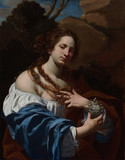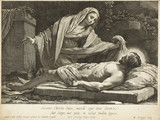Considered one of the most influential French artists of his generation, Simon Vouet was born in Paris but divided his career between Rome and his native city. His initial training came from his father, a minor artist. By the age of fourteen, the younger Vouet had visited England; he later traveled to Constantinople and Venice before settling in Rome in 1614. He remained in Rome until 1627, supported by a pension from Louis XIII and patronage from the powerful Barberini family, as well as other aristocratic and ecclesiastical patrons in Rome, Genoa, and Naples. His early reputation was as a portrait painter. The influence of Caravaggio’s naturalism and tenebrism—a style of painting that engulfs most figures in shadow while dramatically illuminating others is evident in Vouet’s portraits and major religious commissions. Vouet was elected president of the Academy of Saint Luke in 1624 and played an integral part in the development of the Roman school and the articulation of the Baroque style. A skilled draftsman, Vouet’s assimilation of the classicism of Annibale Carracci and Guido Reni and the illusionism of Lanfranco is evident in his decoration of the vault of San Lorenzo in Lucina, as well as in his fresco altarpiece for Saint Peter’s Basilica, for which Two “Modelli” for Two Groups of Angels was painted. Toward the end of his residence in Rome, Vouet painted Virginia da Vezzo, the Artist’s Wife, as the Magdalen (LACMA).
In 1627 Louis XIII recalled Vouet to Paris and appointed him premier Peintre du Roi. The presence of the famous painter transformed the artistic life in Paris. Vouet received major commissions from the Crown for paintings to decorate the palaces of the Louvre, Saint-Germain, and Luxembourg, as well as from the king’s adviser Cardinal Richelieu and other prominent patrons. Many of his great decorations have since been destroyed, and most of his religious paintings were removed from churches during the French Revolution. In Paris, Vouet’s palette lightened and his style became more decorative. Surrounded by a circle of collaborators and students, he was a significant influence on the next generation of French painters. In 1648, the year before his death, Vouet played an important role in the founding of the Royal Academy of Painting and Sculpture.




